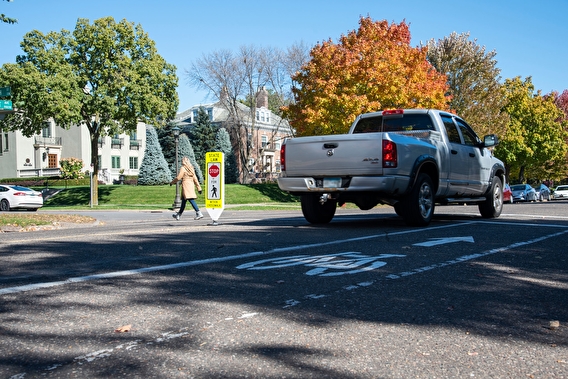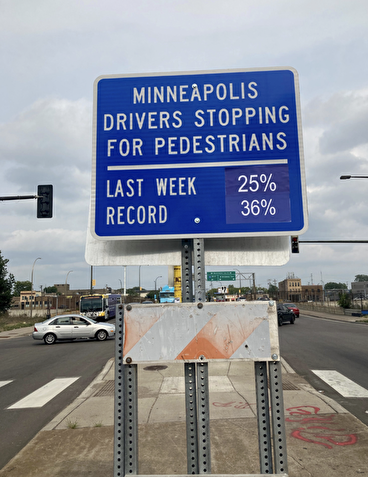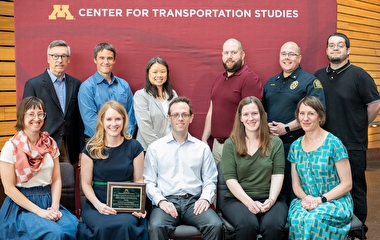
It’s a dangerous time for pedestrians, with deaths at a 30-year high nationally—a trend mirrored in Minnesota. As a result, pedestrian crashes are a top concern for the Minnesota Department of Transportation and local transportation agencies; reducing the danger is key for meeting the state’s Toward Zero Deaths goals and supporting healthy, livable communities.
In an expansion of a 2018 study, U of M researchers examined how engineering solutions might improve driver yielding to pedestrians at intersections. “Despite crosswalk laws, improving the yielding rates has been challenging,” says Nichole Morris, director of the U of M's Human Factors Safety Laboratory (formerly the HumanFIRST Lab) and the project’s principal investigator.
The previous study took a multifaceted approach to unsignalized intersections that included low-cost engineering solutions combined with high-visibility enforcement at sites in St. Paul. In the new study, the team added signalized intersections and expanded into Minneapolis. “We also examined the efficacy of the program without the police enforcement,” Morris explains. This latest work was sponsored by MnDOT and the Minnesota Local Road Research Board.
The study began with a literature review, followed by a 26-week data collection effort in 2021. Researchers originally intended to incorporate the effects of police enforcement. “However, we removed the police component at the study’s start because of the strained climate surrounding police in the region and uncertainty about the ability to enforce crosswalk laws,” Morris says. The final study design compared the effects at signalized and unsignalized intersections with and without engineering treatment.
The study sites were selected in collaboration with city, county, and state partners; priority was given to sites with a history of pedestrian crashes. First, 10 weeks of baseline data was collected at 16 signalized and 16 unsignalized intersections across both cities.
Roughly half of the sites (14 intersections) received engineering countermeasures: hardened centerlines and advanced stop bars at signalized intersections, pedestrian crossing signs and temporary pedestrian refuges at unsignalized intersections.

Community feedback signs (displaying the percentage of drivers stopping for pedestrians) were installed at 14 locations.
Eighteen of the study intersections without additional treatments were used as generalization sites to determine if the effects of treated sites spread to nearby untreated intersections. The project also included outreach efforts to ensure community buy-in and understanding.
The team found modest improvements at treatment sites, Morris says. For the unsignalized sites with engineering treatments, yielding improved from 48 to 65 percent in St. Paul and from 20 to 39 percent in Minneapolis. During this time, yielding rates at unsignalized sites without treatment decreased slightly.
At treated signalized intersections, right-turn yielding improved in Minneapolis, but it did not significantly improve in St. Paul. However, given decreases at the generalization sites, it’s possible the treatments in St. Paul may have countered a decline, Morris suggests.
Unlike the previous study, investigators found no evidence of citywide cultural shifts due to engineering or outreach. “We learned through this work that while localized safety treatments can effectively increase yielding at high-risk intersections, a more general cultural shift in drivers will likely require an enforcement component,” Morris says.
Unrelated factors such as the pandemic—and the increase in risky driving overall—may have skewed results, she adds.
Researchers made several conclusions and recommendations based on the study’s findings:
- Effective interventions vary for right and left turns at signalized intersections.
- Community feedback signs are most effective when used with other interventions and when yielding rates are above 50 percent.
- Unsignalized crosswalks should have additional treatments even when marked.
Regarding high-visibility enforcement campaigns, researchers found in the 2018 study that if police enforcement at crosswalks is planned, it should be widely announced in advance. Police should issue warnings rather than tickets, and other community members should be present during outreach events.
“This research showed that no single countermeasure will increase driver yielding rates toward pedestrians,” says Amber Dallman, director of MnDOT’s Office of Sustainability and Public Health and the study’s technical liaison. “Combinations of different strategies are needed for pedestrian safety. We still have some issues to explore to ensure safe multimodal travel for everyone.”
—Megan Tsai, contributing writer


